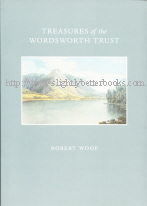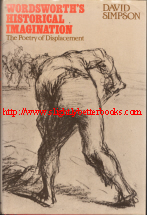
2005, The Wordsworth Trust, pbk
In stock, click to buy for £9.99, not including post and packing (which is Amazon's standard charge of £2.80)
Alternative online retailers to try:
Click here to access our prebuilt search for this title on Abebooks
Or click here to access our prebuilt search for this title on Alibris
Or click here to access our prebuilt search for this title on Ebay









|
About this book: Treasures of the Wordsworth Trust has been published to celebrate the opening of the Jerwood Centre by Seamus Heaney on 2nd June 2005. It gives a selection of one hundred items from the Trust's collections of books, manuscripts, paintings, drawings and engravings that have been built up since the Trust's foundation in 1891. Includes colour plates of the following items:
William Wordsworth
1. William Wordsworth (1770-1850). The Christabel Notebook. 1797-1800 Manuscript
2. Joseph Wright of Derby (1734-1797). Ullswater, c.1794-5. Oil on canvas
3. Sir James Lowther, 1st Earl of Lonsdale (1736-1802). Portrait by Thomas Hudson (1701-1779). 1755-6. Oil on canvas
4. William Wordsworth 'The Vale of Esthwaite', 1787, Manuscript
5. William Wordsworth 'An Evening Walk', London: J. Johnson, 1793
6. William Wordsworth, 'Descriptive Sketches', London: J. Johnson, 1793
7. William Wordsworth, 'The Windy Brow Notebook', 1792-4, Manuscript
8. David Cox (1783-1859), Morecambe Bay, Lancaster Sands, 1842, Oil on Canvas
9. William Wordsworth 'The Ruined Cottage', 1798, Manuscript
10. William Wordsworth, The Alfoxden Notebook, 1797-1802, Manuscript
11. Francis Nicholson (1753-1844), Tintern Abbey, 1804, Watercolour
12. William Wordsworth and Samuel Taylor Coleridge, Lyrical Ballads, London: J. and A. Arch, 1798
13. William and Dorothy Wordsworth, Letter to Samuel Taylor Coleridge, 14-21 December 1798, Manuscript
14. Amos Green (1735-1807), Town End, c.1806, Watercolour
15. William Wordsworth, 'Home at Grasmere', 1806. Manuscript
16. William Wordsworth, Lines from 'Michael', 1800, Manuscript
17. William Wordsworth, Lyrical
Ballads, with other poems. London: T.N. Longman and O. Rees, 1800
18. Dorothy Wordsworth (1771-1855), Portrait by and unknown artist, c. 1806. Silhouette
19. Dorothy Wordsworth, Journal, 14 February - 2 May 1802. Manuscript
20. Dorothy Wordsworth, Journal, May 1802 - January 1803. Manuscript
21. William Wordsworth, Letter to Mary Wordsworth, 22 July 1810. Manuscript
22. Priscilla Wordsworth
, née Lloyd (d.1815). Portrait by John Constable (1776-1837), December 1806. Pencil
23. William Wordsworth. Portrait by Henry Edridge (1769-1821), May 1806. Pencil and Watercolour
24. William Wordsworth. The Thirteen Book Prelude. 1805. Manuscript
25. Sir George Beaumont (1753-1827). Peele Castle in a Storm,
c. May 1806. Oil on canvas
26. Lady Beaumont (1756-1829). Portrait by Sir Joshua Reynolds, 1788-9. Oil on canvas
27. Sir George Beaumont (1753-1827) by Peter Bell, 1808, Oil on canvas
28. Joseph Wilkinson (1764-1831): Select Views in Cumberland, Westmoreland and Lancashire. London: for the Reverend Joseph Wilkinson, 1810
29.
William Wordsworth, The Excursion Book IV and parts of Book I, Manuscript
30. William Wordsworth, Portrait by Richard Carruthers (1792-1876), 1818. Oil on canvas
31. William Wordsworth, Portrait by Benjamin Robert Haydon (1786-1846). Inscribed 'Wordsworth. For Entry into Jerusalem. 1819'. Pencil
32. William Wordsworth. Ecclesiastical Sketches, Manuscript
33. Dora Wordsworth (1804-1847). Portrait by Margaret Gillies
34. Rotha Quillinan (1821-1876). Portrait by Sir William Boxall (1800-1879), dated 8 May 1832. Oil on canvas
35. William Wordsworth (1770-1850), Portrait by Benjamin Robert Haydon, 1843. Oil on canvas
The Age of British Romaniticism
36. Samuel Taylor Coleridge (1772-1834). Verse letter to Sara Hutchinson, 1802. Manuscript
37.
Samuel Taylor Coleridge, portrait by George Dance (1741-1825), dated 21 March 1804, pencil
38. Samuel Taylor Coleridge, portrait by James Northcote (1746-1831), 1804. Oil on canvas
39. Charles Lloyd (1775-1839), Poems on the Death of Priscilla Farmer, Bristol: N. Biggs, 1796
40. Samuel Taylor Coleridge, portrait by Washington Allston (1779-1843), 1814. Oil on canvas
41. Hartley Coleridge (1796-1849), portrait by Sir David Wilkie (1745-1841), 1806. Oil on canvas
42.
Robert Southey (1774-1843), portrait by Thomson Phillips (1770-1845), c.1818, Oil on canvas
43. Caroline Bowles (1786-1854). Robert Southey's Study and Greta Hall, February 1841, Watercolour
44. Charles Lamb (1775-1834) and Mary Lamb (1764-1847). Portrait by Francis Cary (1808-1880), 1834. Oil on canvas
45. John Wilson (1785-1854), portrait by Sir Henry Raeburn (1756-1823). Oil on canvas
46. Thomas De Quincey (1785-1859). Letter to John Wordsworth, 28 March 1809. Manuscript
47. Thomas De Quincey, Portrait by James Archer (1823-1904), 1855, chalk
48. Thomas De Quincey, Confessions of an English Opium Eater, 1821, Manuscript
49. William Hazlitt (1778-1830), Portrait by William Bewick (1795-1866), 1824. Chalk
50. William Hazlitt, On Egotism, c. 1826. Manuscript
51. Thomas Moore (1779-1852). The Fudge Family in Paris. London: Longman, Hurst, Rees, Orme and Brown, 1818
52. William Godwin (1756-1836), Portrait by Francis Chandler (c.1770-1804/5), 1798. Oil on canvas
53. William Godwin. An Enquiry Concerning Political Justice. London: G. G. J. and J. Robinson, 1792
54. Mary Wollstonecraft (1759-1792). A Vindication of the Rights of Woman. London: Joseph Johnson, 1792
55. Joseph Severn (1793-1879). Shelley Composing Prometheus Unbound in the Baths of Caracalla, 1845. Oil on canvas
56. Percy Bysshe Shelley (1792-1822), 'Epipsychidion'. London: C. and J. Ollier, 1821
57. Percy Bysshe Shelley, 'Adonais, An Elegy
on the Death of John Keats', Pisa: 1821
58. Mary Shelley (1797-1851). Frankenstein: or the Modern Prometheus. Lonodon: Lacking, Hughes, Harding, Mayor & Jones, 1818
59. Lord Byron (1788-1824). Portrait by Richard Westall (1765-1836), 1813. Oil on canvas
60. Lord Byron. Hours of Idleness. A Series of Poems, Original and Translated. Newark: S. and J. Ridge, 1807
61. Thomas Love Peacock (1785-1866). Nightmare Abbey, London: T. Hookham Junior, 1818
62. Leigh Hunt (1784-1859). Portrait by Benjamin Robert Haydon, c.1811. Oil on canvas
63. The Liberal. Verse and Prose from the South. Issue One. London: John Hunt, 1822
64. Benjamin West seated and talking to John Opie and Benjamin Robert Haydon. Portrait by Thomas Stothard (1755-1834)
65. Benjamin Robert Haydon (1786-1846). Letter to William Wordsworth. 31 December 1816. Manuscript
66. John Keats (1795-1821). Lifemask by Benjamin Robert Haydon, 1816. White plaster cast
67. John Keats, poems. London: C. and J. Ollier, 1817
68. John Keats, Lamia, Isabella, the Eve of St. Agnes and other Poems. London: Taylor and Hessey, 1820
69. J. M. W. Turner (1775-1851). A View of Menaggio, Lake Como, 1842-3. Pencil and watercolour
70. Charlott, Emily and Anne Bronte, poems by Currer, Ellis and Acton Bell. London: Smith, Elder & Co., 1846
The Discovery of the Lake District
71. Jean-Baptiste Claude Chatelin & Francois Simon Ravenet after William Bellers. 'A View of Derwentwater, Towards Borrodale', London: Boydell and Sayer, 17 January 1774. Engraving and etching
72.
Thomas Smith (d. 1767). A View of Darwentwater &c. from Crow-Park. London: John Boydell, 1767. Line engraving
73. Lady Mary Lowther (1739-1829). 'Winander-Mere, the Long Island, Bonus, Rayrigg's &c &c, a Peep of the Sea of Milthorp & Lancaster with the Castle, from the 'Top of Orrost', 1767. Watercolour
74. Lady Mary Lowther 'Part of Ulls Water, a distant View of Kirkstone Paterdale, the Church & Hall, St. Sundays Craggs, Stybury Craggs, Glen Redding Pykes Glen Coyen, Birch Fell, from Govery High Park, 1767. Watercolour
75. Joseph Farington (1747-1821), View towards Latrigg, dated 17 October 1775, watercolour
76. Joseph Farington, Grasmere, dated 14 June 1777. Pencil, pen and wash
77. Joseph Farington, Lodore Waterfall, Westmoreland, 1785. Pen and ink, watercolour
78. Thomas Hearne (1744-1817), Sir George Beaumont and Joseph Farington painting a Waterfall, 1777. Pen and wash
79. Thomas Hearne, 'The West Aspect of Furness Abbey, Cumbria', dated 6 August 1777. Watercolour
80. Paul Sandby (1730-1809), 'Keswick Lake', c.1780. Gouache
81. Thomas Gainsborough (1727-1788), 'Langdale Pikes', 1783. Pencil and wash
82. John Bernard Gilpin (1701-1776), 'Rocky Pool'. Pen and wash
83. William Gilpin (1724-1804), 'Ideal Scene', c.1786. Pen and wash
84. John 'Warwick' Smith (1749-1831), 'Windermere', 1788-92. Watercolour
85. John 'Warwick' Smith, 'The Upper End of Coniston Lake, Cumbria', dated 1801. Pencil and watercolour
86. Francis Towne (1740-1816), Elterwater, Cumberland, dated 1786. Pen and ink, watercolour
87. Francis Towne, 'A Valley in the Lake District', dated 4th September, 1786. Pen and ink, watercolour
88. John White Abbott (1763-1851), Grasmere, Helm Crag, dated 12 July 1812. Watercolour
89. John Laporte (1761-1839), Vale of Keswick from Ashness Bridge, c.1800. Watercolour and bodycolour
90. James Gillray (1757-1815), Mary of Buttermere, 1800. Pencil, pen and ink
91. Edward Dayes (1763-1804), Keswick Lake and Skiddaw, 1791. Pen, blue and grey wash
92. Thomas Girtin (1775-1802), Borrowdale, c.1801. Pencil and watercolour
93. John Constable (1776-1837), Langdale Pikes from Elterwater, dated 4 September, 1806. Pencil
94. John Constable (1776-1837), Helvellyn, dated 21 September 1806. Watercolour
95. William Green (1760-1823), Grasmere, 1802. Watercolour
96. William Havell (1782-1857), Waterfall at Ambleside, seen through a window, 1807. Watercolour
97. Thomas Rowlandson (1756-1827), Doctor Syntax Sketching the Lake, c.1812. watercolour
98. George Fennel Robson (1788-1833), Grasmere, c.1830. Watercolour
99. Edward Lear (1812-1888), Grasmere, dated 5 October 1836. Pencil and watercolour
100. James Baker Pyne (1800-70), Windermere from Orrest Head, dated 1849. Oil on canvas
|
The English Romantic Period
William Wordsworth Books
Wordsworth and Coleridge
|





